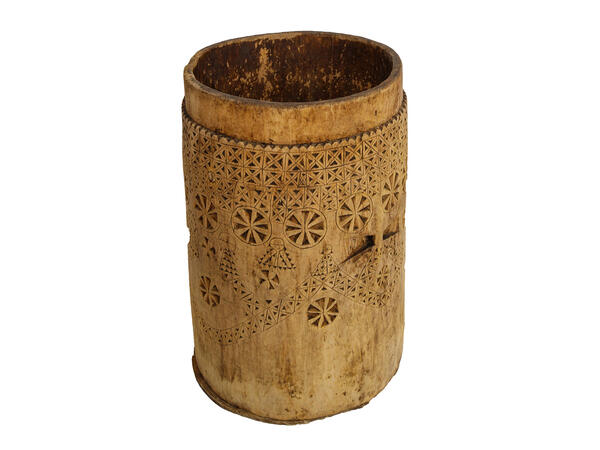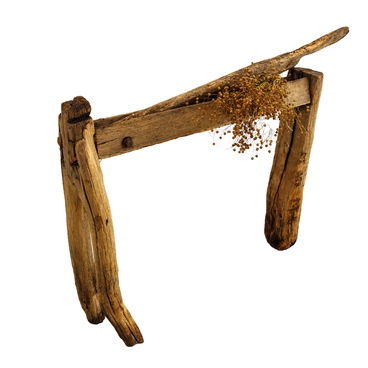In the traditional Mokshan and Erzyan culture, a cylindrical dugout container was called a “par”
The tub for storing clothes, presented in the exhibition, is hollowed out from the whole trunk of a linden tree. The bottom consists of two boards and is attached to the walls with nails. The par' is richly ornamented in the technique of triangular-chip carving. From the upper edge downwards there is a band of ribbon-shaped geometric ornament. It consists of four rows of squares, each of which is divided into four triangles. Below are circles: solar signs (symbols of the universe) in the shape of an eight-petal socket. Anthropomorphic figures are placed among them.
Only whole trunks of linden trees were used to make par’s: the Erzyan considered this tree “pure”. From one tree it was possible to make two or three tubs of about one meter high. Their walls were up to 2 centimeters thick. The biggest par' was about 80 centimeters in diameter.
Similar containers in the old days were used to store various products. Depending on their purpose, they were called differently. For example, flour was put into “pochfton par' “, and dough — into “shapaks par' “. Home brewed beer was stored in “poza par' “, salt — in “sal par' “, and “pikhtembar” was used to make butter. Par' in which food was kept were never ornamented.
The most famous and revered variety of par was “eryamo par' " — “a life tub” in which girls kept their dowry. Sometimes they were called “odirvan par' “, which translated means “bride’s tub”. According to Mordovian legends, a girl marrying “died” to the family she was born into, and all her personal belongings after the wedding were to be kept in that tub.
Masters-carvers paid special attention to the decoration of such tubs: the meaning ща еру ornament was not only decorative but also sacral. Simple geometric shapes — triangles, squares, circles — made up ornamental bands. Each of horizontal tiers contained a pattern of one or two motifs. A girl’s “eryamo par' " was made by her father or elder brother, or was bought by her future father-in-law.
On the lid of the tub there is a forged iron bracket which was locked with a padlock. Putting the dowry into the par' was one of the most important wedding rituals, so all actions were performed in a strict order. Married female relatives of the bride would stack the bride’s belongings in the tub in the seni (hallway), which had no earth on the ceiling. According to the traditions of the Mordvin people, it was possible to prepare only the dead between “two earths”, and not the living otherwise they “would not be living”, i.e. their marriage would not be long-lived.
At first the par' was cleansed from evil forces by “live fire” — a linden lighted with a rushlight, then it was consecrated by an icon. The first to be put in the tub was the “bread of health” — “shumbra kshi”. After that, five silver coins were put on the bottom: four at the edges and one in the middle, on the bread. The woman who performed this sacrament accompanied her actions with the words:
The tub for storing clothes, presented in the exhibition, is hollowed out from the whole trunk of a linden tree. The bottom consists of two boards and is attached to the walls with nails. The par' is richly ornamented in the technique of triangular-chip carving. From the upper edge downwards there is a band of ribbon-shaped geometric ornament. It consists of four rows of squares, each of which is divided into four triangles. Below are circles: solar signs (symbols of the universe) in the shape of an eight-petal socket. Anthropomorphic figures are placed among them.
Only whole trunks of linden trees were used to make par’s: the Erzyan considered this tree “pure”. From one tree it was possible to make two or three tubs of about one meter high. Their walls were up to 2 centimeters thick. The biggest par' was about 80 centimeters in diameter.
Similar containers in the old days were used to store various products. Depending on their purpose, they were called differently. For example, flour was put into “pochfton par' “, and dough — into “shapaks par' “. Home brewed beer was stored in “poza par' “, salt — in “sal par' “, and “pikhtembar” was used to make butter. Par' in which food was kept were never ornamented.
The most famous and revered variety of par was “eryamo par' " — “a life tub” in which girls kept their dowry. Sometimes they were called “odirvan par' “, which translated means “bride’s tub”. According to Mordovian legends, a girl marrying “died” to the family she was born into, and all her personal belongings after the wedding were to be kept in that tub.
Masters-carvers paid special attention to the decoration of such tubs: the meaning ща еру ornament was not only decorative but also sacral. Simple geometric shapes — triangles, squares, circles — made up ornamental bands. Each of horizontal tiers contained a pattern of one or two motifs. A girl’s “eryamo par' " was made by her father or elder brother, or was bought by her future father-in-law.
On the lid of the tub there is a forged iron bracket which was locked with a padlock. Putting the dowry into the par' was one of the most important wedding rituals, so all actions were performed in a strict order. Married female relatives of the bride would stack the bride’s belongings in the tub in the seni (hallway), which had no earth on the ceiling. According to the traditions of the Mordvin people, it was possible to prepare only the dead between “two earths”, and not the living otherwise they “would not be living”, i.e. their marriage would not be long-lived.
At first the par' was cleansed from evil forces by “live fire” — a linden lighted with a rushlight, then it was consecrated by an icon. The first to be put in the tub was the “bread of health” — “shumbra kshi”. After that, five silver coins were put on the bottom: four at the edges and one in the middle, on the bread. The woman who performed this sacrament accompanied her actions with the words:



